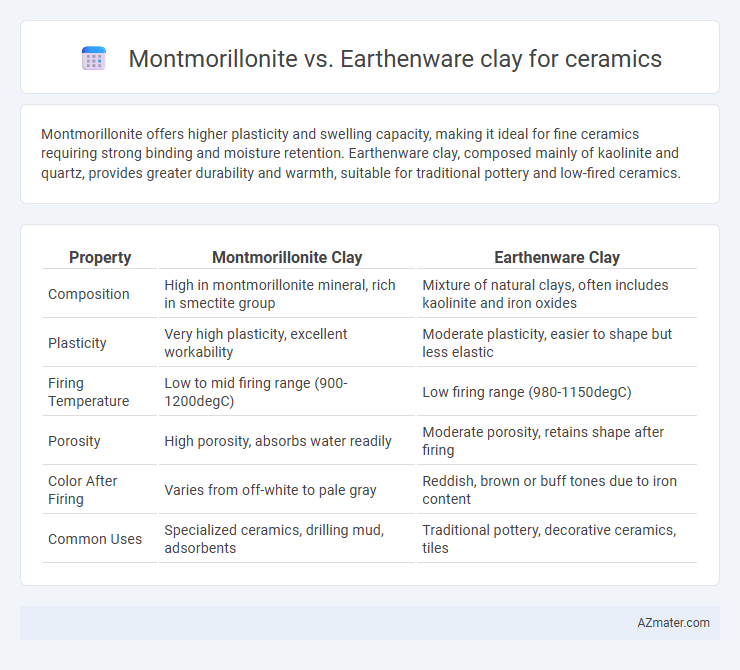Montmorillonite offers higher plasticity and swelling capacity, making it ideal for fine ceramics requiring strong binding and moisture retention. Earthenware clay, composed mainly of kaolinite and quartz, provides greater durability and warmth, suitable for traditional pottery and low-fired ceramics.
Table of Comparison
| Property | Montmorillonite Clay | Earthenware Clay |
|---|---|---|
| Composition | High in montmorillonite mineral, rich in smectite group | Mixture of natural clays, often includes kaolinite and iron oxides |
| Plasticity | Very high plasticity, excellent workability | Moderate plasticity, easier to shape but less elastic |
| Firing Temperature | Low to mid firing range (900-1200degC) | Low firing range (980-1150degC) |
| Porosity | High porosity, absorbs water readily | Moderate porosity, retains shape after firing |
| Color After Firing | Varies from off-white to pale gray | Reddish, brown or buff tones due to iron content |
| Common Uses | Specialized ceramics, drilling mud, adsorbents | Traditional pottery, decorative ceramics, tiles |
Introduction to Montmorillonite and Earthenware Clay
Montmorillonite is a highly absorbent, fine-grained clay mineral predominantly composed of smectite, known for its swelling properties and plasticity, making it ideal for enhancing ceramic bodies. Earthenware clay, typically composed of natural clay minerals mixed with iron oxides, provides a coarse texture and fires at lower temperatures around 1000-1150degC, resulting in porous, reddish ceramics. The key distinction lies in Montmorillonite's superior plasticity and shrinkage control compared to the more porous and less plastic earthenware clay used for traditional pottery.
Geological Origins and Composition
Montmorillonite is a type of smectite clay formed primarily from the weathering of volcanic ash and is characterized by its high swelling capacity and fine particle size, largely composed of hydrous aluminum silicate. Earthenware clay originates from sedimentary deposits rich in kaolinite, quartz, and iron oxide, which contribute to its plasticity and reddish-brown color after firing. Geological distinctions between montmorillonite and earthenware clays influence their mineralogical composition and firing behavior, crucial for ceramic craftsmanship.
Physical Properties: Texture and Plasticity
Montmorillonite clay exhibits a fine-grained texture with high plasticity, making it highly moldable and ideal for intricate ceramic forms due to its ability to retain shape without cracking. In contrast, earthenware clay has a coarser texture and lower plasticity, which can limit its workability but contributes to its durability after firing. The superior water retention and swelling properties of montmorillonite enhance its flexibility during shaping, whereas earthenware's granular composition results in less shrinkage and higher porosity in the finished ceramic.
Water Absorption and Shrinkage Rates
Montmorillonite clay exhibits higher water absorption due to its layered structure and swelling properties, resulting in increased porosity after firing. Earthenware clay, with lower montmorillonite content, generally shows reduced water absorption and better dimensional stability. Shrinkage rates are typically greater in montmorillonite-rich clays because of their fine particle size and plasticity, whereas earthenware clay exhibits moderate shrinkage suitable for structural ceramics.
Firing Temperatures and Kiln Compatibility
Montmorillonite clay typically fires at lower temperatures ranging from cone 04 to cone 04 (approximately 1060-1100degC), making it suitable for low-fire ceramic projects and compatible with electric kilns. Earthenware clay fires at similar low temperatures but can tolerate temperatures up to cone 06 (around 990-1050degC), optimized for oxidation atmospheres common in electric or gas kilns. Both clays offer good plasticity and workability, but Montmorillonite's finer particle structure often results in slightly different thermal behavior during firing.
Color Outcomes After Firing
Montmorillonite clay typically results in lighter, more translucent color outcomes after firing due to its fine particle size and high flux content, which promotes vitrification. Earthenware clay, rich in iron oxides and other impurities, develops warmer, earth-toned hues ranging from red to brown, often with a matte or slightly porous surface. The mineral composition and firing temperature differentially affect the final color, with Montmorillonite favoring subtle, cool tones and Earthenware producing rich, rustic shades.
Workability for Handbuilding and Wheel Throwing
Montmorillonite clay offers superior plasticity and fine particle size, making it ideal for both handbuilding and wheel throwing due to its smooth, workable texture that retains moisture well. Earthenware clay has a coarser texture with less plasticity, which can challenge wheel throwing but remains manageable for handbuilding applications with slower drying times and moderate shrinkage rates. The higher shrinkage and lower plasticity of earthenware require careful moisture control, whereas montmorillonite's consistent workability supports intricate shaping across both forming techniques.
Glaze Interaction and Suitability
Montmorillonite, a highly absorbent and plastic clay mineral, enhances glaze fit by reducing crazing and promoting even surface tension in ceramics, making it ideal for glaze formulations requiring stronger adherence. Earthenware clay, with its lower plasticity and higher porosity, often requires careful glaze composition adjustments to prevent pinholing and blistering during firing. Montmorillonite's fine particles and swelling properties improve glaze interaction and durability, while earthenware's coarser texture limits compatibility with certain glaze types, favoring simpler, low-fire glazes.
Durability and Finished Product Use
Montmorillonite clay offers superior plasticity and shrinkage control compared to earthenware clay, resulting in ceramics with higher durability and resistance to cracking or warping during firing. Earthenware clay, while more porous and less durable, is ideal for decorative items or functional wares that do not require high strength or water resistance. Finished products made from montmorillonite clay exhibit enhanced mechanical strength and longevity, making them suitable for functional tableware or structural ceramics.
Choosing the Right Clay for Your Ceramic Project
Montmorillonite clay offers high plasticity and superior workability, making it ideal for intricate ceramic designs and wheel throwing, whereas Earthenware clay is more porous and fires at lower temperatures, best suited for rustic, durable pottery and decorative items. Montmorillonite's fine particle size ensures smooth, detailed finishes, while Earthenware's iron content often imparts warm, natural hues that appeal to traditional styles. Choosing the right clay depends on desired project durability, firing temperature, and finish texture, with Montmorillonite favored for precision and Earthenware preferred for aesthetic warmth and versatility.

Infographic: Montmorillonite vs Earthenware clay for Ceramic
 azmater.com
azmater.com